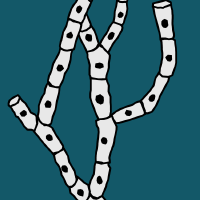Topic Menu
► Topic MenuTopic Editors


Recent Results in the Research of Cryptogamic Organisms – Symbiosis, Ecophysiology, Conservation, Application
Topic Information
Dear Colleagues,
The phrase “cryptogamic organisms” (having “hidden reproduction”) cover the otherwise very different algae, fungi, lichens, mosses, and ferns, which are only combined by a common feature that they do not produce flowers or seeds, a form of sexual reproduction in flowering plants. Although the modes of their asexual and vegetative reproduction are very different, their life strategies are similar in a series of other fields requiring an interdisciplinary approach. Thanks to molecular genetic methods, the phylogeny of these groups has been clarified in several points, and thus their taxonomy has been faced with revolutionary changes. Symbiosis is the best studied in lichens, and thus it is now treated at a further level, not only considering the two main partners— photobionts and mycobionts—but also non-photosynthetic bacteria, as well as the multiplied fungal and photosynthetic partners co-existing with them. Symbiotic partners in other groups of cryptogamic organisms are less known, and the roles of these partners require further studies. Among recent methodological advances, DNA-based microbiome studies offer unprecedented insights into the taxonomic and functional composition of microorganisms associated with all groups of cryptogamic organisms. The poikilohydric nature of many cryptogamic organisms, combined with often extreme levels of desiccation tolerance, places them in the focus of ecophysiological studies. In addition, the understanding of mechanisms related to the secondary metabolites unique to lichens produced as protecting agents against high solar and UV radiation need more information. Even though most cryptogamic organisms are tiny, they live in the form of various-sized thalli, colonies, crusts, mats, or clumps, and they represent the foundation of both terrestrial and aquatic ecosystems as colonizers of soil and rock surfaces and make up a large proportion of the planet’s photosynthesizing biomass. They are hyperdiverse, and many of them are ubiquitous, while some are restricted to habitats that are often endangered and in need of conservation. Additionally, their application and utilization in human life have so far been underexplored.
Prof. Dr. Edit Farkas
Dr. József Geml
Dr. Michal Goga
Dr. Katalin Veres
Topic Editors
Keywords
- application
- bryophytes
- cyanobacteria
- conservation
- desiccation tolerance
- ecophysiology
- green algae
- lichens
- lichen secondary metabolites
- symbiosis
Participating Journals
| Journal Name | Impact Factor | CiteScore | Launched Year | First Decision (median) | APC |
|---|---|---|---|---|---|

Diversity
|
2.1 | 3.4 | 2009 | 15.4 Days | CHF 2100 |

Ecologies
|
1.7 | 1.8 | 2020 | 25.6 Days | CHF 1000 |

Journal of Fungi
|
4.2 | 6.7 | 2015 | 17.1 Days | CHF 2600 |

Microorganisms
|
4.1 | 7.4 | 2013 | 13.4 Days | CHF 2700 |

Plants
|
4.0 | 6.5 | 2012 | 18.2 Days | CHF 2700 |

MDPI Topics is cooperating with Preprints.org and has built a direct connection between MDPI journals and Preprints.org. Authors are encouraged to enjoy the benefits by posting a preprint at Preprints.org prior to publication:
- Immediately share your ideas ahead of publication and establish your research priority;
- Protect your idea from being stolen with this time-stamped preprint article;
- Enhance the exposure and impact of your research;
- Receive feedback from your peers in advance;
- Have it indexed in Web of Science (Preprint Citation Index), Google Scholar, Crossref, SHARE, PrePubMed, Scilit and Europe PMC.



